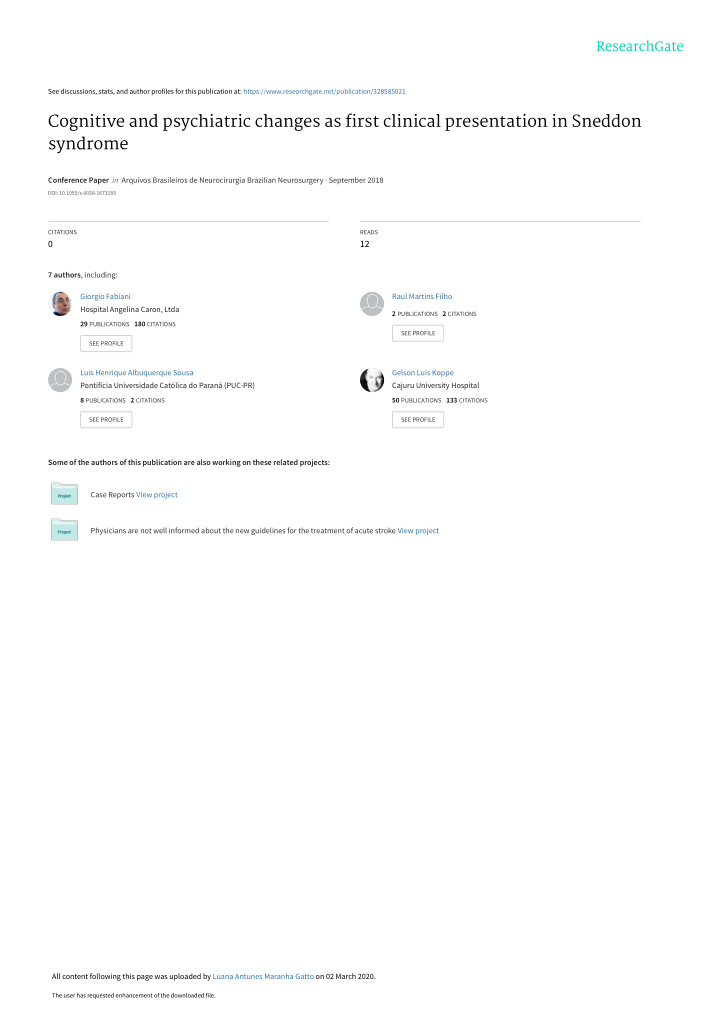



See discussions, stats, and author profiles for this publication at: https://www.researchgate.net/publication/328585021 Cognitive and psychiatric changes as first clinical presentation in Sneddon syndrome Conference Paper in Arquivos Brasileiros de Neurocirurgia Brazilian Neurosurgery · September 2018 DOI: 10.1055/s-0038-1673185 CITATIONS READS 0 12 7 authors , including: Giorgio Fabiani Raul Martins Filho Hospital Angelina Caron, Ltda 2 PUBLICATIONS 2 CITATIONS 29 PUBLICATIONS 180 CITATIONS SEE PROFILE SEE PROFILE Luis Henrique Albuquerque Sousa Gelson Luis Koppe Pontifícia Universidade Católica do Paraná (PUC-PR) Cajuru University Hospital 8 PUBLICATIONS 2 CITATIONS 50 PUBLICATIONS 133 CITATIONS SEE PROFILE SEE PROFILE Some of the authors of this publication are also working on these related projects: Case Reports View project Physicians are not well informed about the new guidelines for the treatment of acute stroke View project All content following this page was uploaded by Luana Antunes Maranha Gatto on 02 March 2020. The user has requested enhancement of the downloaded file.
Case Report Dement Neuropsychol 2018 June;12(2):216-219 http://dx.doi.org/10.1590/1980-57642018dn12-020016 Cognitive and psychiatric changes as first clinical presentation in Sneddon syndrome Giorgio Fabiani 1 , Raul Martins Filho 2 , Gelson Luis Koppe 3 , Zeferino Demartini Jr 4 , Luana Antunes Maranha Gatto 4 ABSTRACT. Sneddon syndrome (SS) is a rare progressive non-inflammatory thrombotic vasculopathy affecting small/ medium-sized blood vessels of unknown origin. It is strongly associated with the presence of antiphospholipid antibodies (AA). The presence of livedo reticularis and cerebrovascular disease are hallmark features. The condition is far more common in young women. We report a case of SS in a 43 year-old male with a two-year history of progressive cognitive impairment consistent with dementia syndrome, and major personality changes, besides livedo reticularis and cerebral angiographic pattern of vasculitis. AA were borderline. The recognition of skin blemishes that precede strokes should raise the hypothesis of SS. AA are elevated in more than half of cases, but their role in the pathogenesis or association of positive antibodies and SS remains unclear. Dementia syndrome in young patients should be extensively investigated to rule out reversible situations. Typical skin findings, MRI and angiography may aid diagnosis. Key words: Sneddon syndrome, central nervous system vasculitis, presenile dementia, vascular dementia, antiphospholipid syndrome. ALTERAÇÕES COGNITIVAS E PSIQUIÁTRICAS COMO PRIMEIRA APRESENTAÇÃO CLÍNICA NA SÍNDROME DE SNEDDON RESUMO. A síndrome de Sneddon (SS) é uma vasculopatia trombótica não inflamatória progressiva rara que afeta os vasos sanguíneos de pequeno e médio tamanho com origem desconhecida. Está fortemente associada à presença de anticorpos antifosfolipídios (AA). A presença de livedo reticularis e doença cerebrovascular são a marca registrada. É muito mais comum em mulheres jovens. Relatamos um caso de SS em um homem de 43 anos de idade com dois anos de história de comprometimento cognitivo progressivo compatível com síndrome demencial e mudanças graves de personalidade, além de livedo reticular e padrão angiográfico cerebral de vasculite. AA eram limítrofes. O reconhecimento das manchas da pele que precedem eventos isquêmicos cerebrovasculares deve reforçar a hipótese de SS. Os AA são elevados em mais da metade dos casos, mas seu papel na patogênese ou associação de anticorpos positivos e SS permanece obscuro. A síndrome demencial em pacientes jovens deve ser amplamente investigada para se descartarem situações reversíveis. Achados típicos da pele, ressonância magnética e angiografia podem ajudar no diagnóstico. Palavras-chave: síndrome de Sneddon, vasculite do sistema nervoso central, demência pré-senil tipo Alzheimer, demência vascular, síndrome antifosfolipídica. I n 1965, Sneddon described 1 six patients syndrome (SS), it is a rare non-infmamma- with a new syndrome whose main symp- tory thrombotic vasculopathy, character- toms included multiple episodes of lacunar ized by cerebrovascular disease and typical subcortical, ischemic infarcts and widespread skin lesions, the livedo reticularis. 1-6 Tie livedo eruption. Today known as Sneddon’s Orpha number for SS is ORPHA820. 2 It has This study was conducted at Serviço de Neurologia do Hospital das Nações. Curitiba, PR, Brazil. 1 Neurologist of Hospital das Nações, Curitiba, PR, Brazil. 2 Radiologist of CETAC – Diagnóstico por Imagem, Curitiba, PR, Brazil. 3 Interventional Neuroradiologist of Hospital das Nações, Curitiba, PR, Brazil. 4 Neurosurgeon and Interventional Neuroradiologist of Hospital das Nações, Curitiba, PR, Brazil. Giorgio Fabiani. Serviço de Neurologia do Hospital das Nações / Serviço de Neurologia do Hospital Angelina Caron – Curitiba PR – Brazil. E-mail: giorgio@berthierfabiani.com.br e giorgiofabiani@icloud.com Disclosure: The authors report no conflicts of interest. Received December 01, 2017. Accepted in final form March 03, 2018. 216 216 Cognitive changes in Sneddon Syndrome Fabiani et al.
Recommend
More recommend